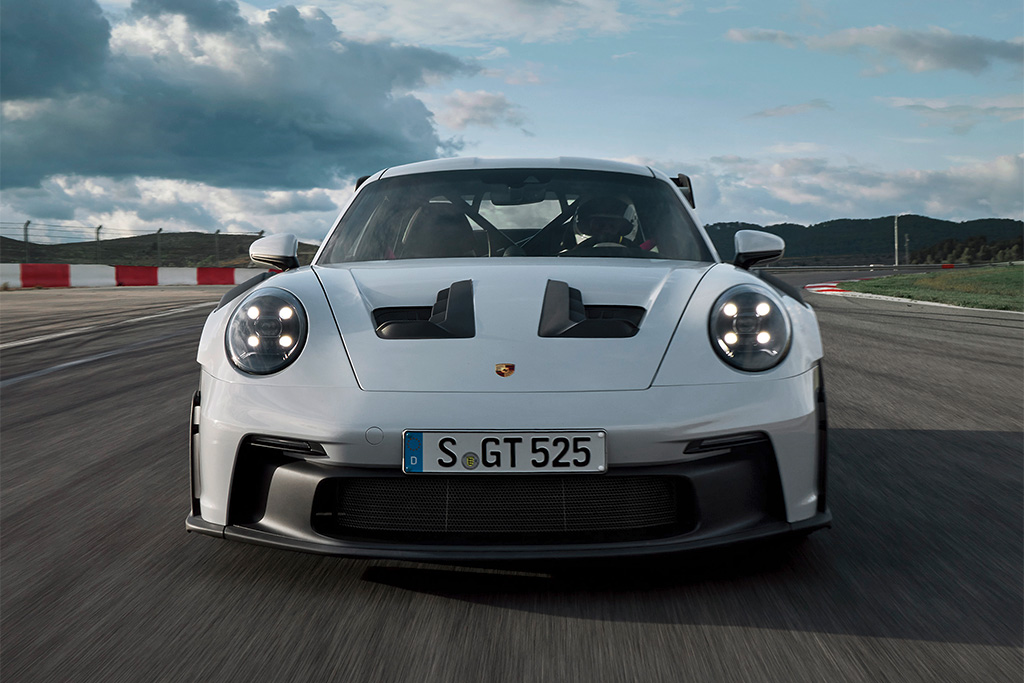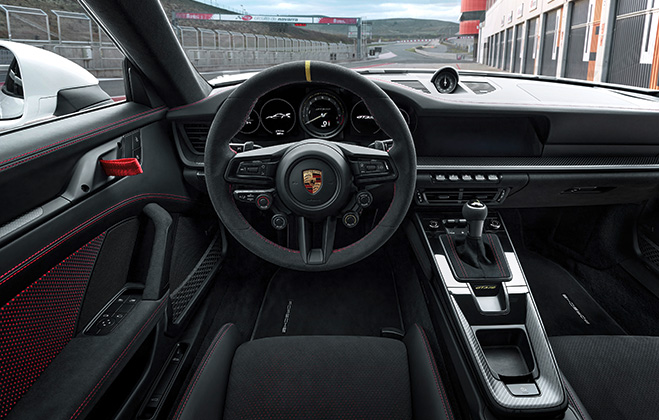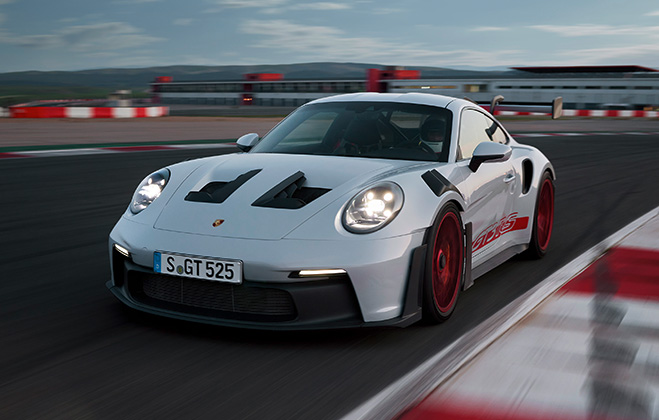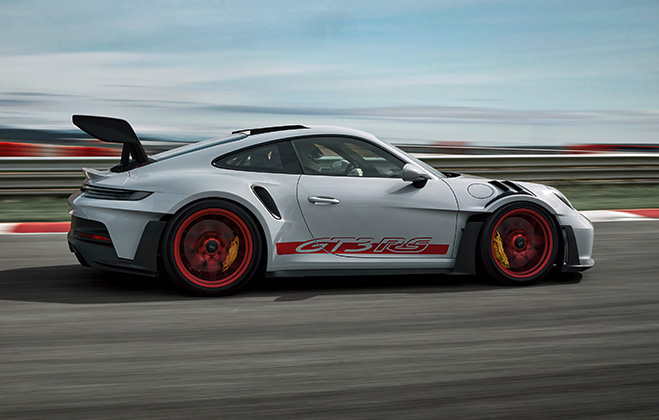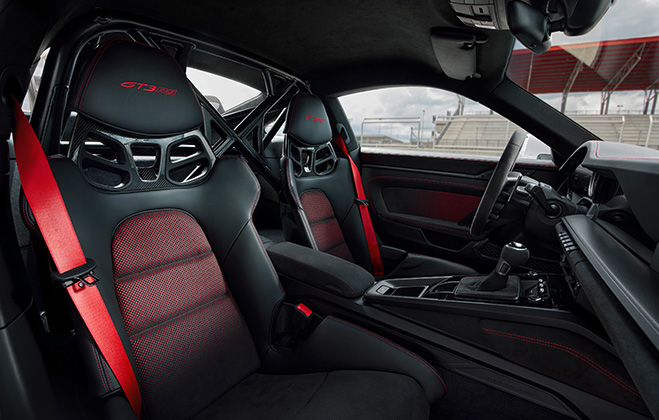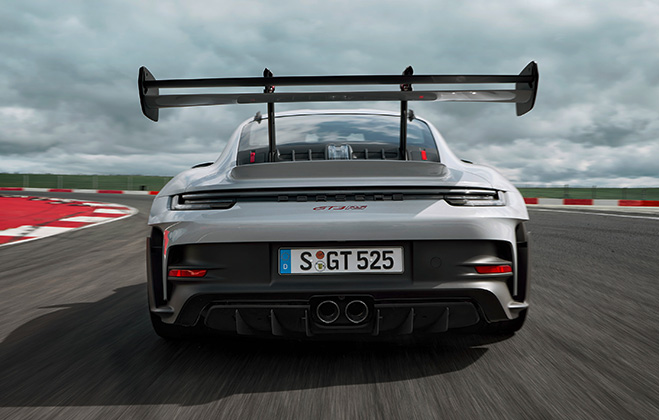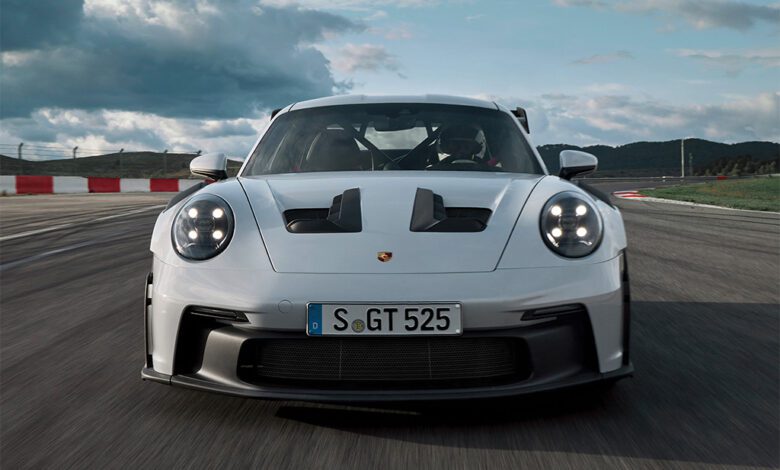
The new Porsche 911 GT3 RS is built for performance
The new Porsche 911 GT3 RS makes no secret of its intentions: it is uncompromisingly designed for maximum performance. The road-legal sports car with 386 kW (525 hp) makes full use of concepts and technical solutions straight from motorsport. Its motorsport siblings, the 911 GT3 R, are directly linked to cooling and aerodynamics in addition to a high-revving naturally aspirated engine with racing DNA and an intelligent lightweight design.
The motorsport-inspired concept of the centrally positioned radiator is the basis of active aerodynamics.
The basis for the significant increase in performance is the concept of a central radiator - an idea that was first used in the 911 RSR, the Le Mans class winner, and then in the 911 GT3 R. Large angular central radiator at the front of the car. It is located where the trunk is on other 911 models. As a result, free space on the sides could be used for active aerodynamic elements.
Infinitely adjustable elements at the front and on the two-piece rear wing, combined with a number of other aerodynamic solutions, provide a total downforce of 409 kg at a speed of 200 km/h. This means that the downforce of the new 911 GT3 RS is twice that of its 991.2 generation predecessor and three times that of the current 911 GT3. At 285 km / h, the total downforce is 860 kg.
The Drag Reduction System (DRS) was installed on the new 911 GT3 RS – a first in Porsche series production.
This allows the wings to be flattened at the touch of a button within a certain operating range, resulting in low drag and higher speed on the straights. During emergency braking at high speed, the aerodynamic braking function is activated: the elements of the wing front and rear are brought to their maximum position, creating an aerodynamic deceleration effect that greatly supports the wheel brakes.
The appearance of the 911 GT3 RS is defined by a large number of functional aerodynamic details.
The most striking feature of the new GT sports car is the gooseneck rear wing, which is significantly enlarged in all directions. The rear wing consists of a fixed main wing and a hydraulically adjustable upper wing. For the first time in a production Porsche, the upper edge of the rear wing is higher than the roof edge. In addition, there is no spoiler at the front of the 911 GT3 RS - there is a splitter that "splits" the air flows above and below the car. Side guides (blades) of air precisely direct its flow outward. The front wheel arches are ventilated through louvered openings in the front fenders. Dynamic wheel arch pressure reduces front wheel pitting in the style of the legendary 911 GT1, Le Mans marathon winner.
The air guides behind them are designed to guide them towards the car. The air from the centrally located radiator exits through large "nostrils" in the front hood. "Fingers" on the roof direct air outward to maintain a cooler inlet temperature to the rear air intakes. The side openings in the rear fenders of the new 911 GT3 RS only serve to improve aerodynamics and not to suck in process air. In order to optimize flow, the rear wheel arches also feature recesses and air guides. The rear diffuser is taken from the 911 GT3, but here it is slightly modified.
Crawler suspension, adjustable from the cab
Even the suspension is designed with aerodynamics in mind. While the wheel arches of the new 911 GT3 RS struggle with intense airflow, the double-wishbone front suspension components feature a drop-shaped profile with aerodynamic effects. This solution is only used for advanced motorsport applications. The result: at maximum speed, the downforce on the front axle is increased by about 40 kg. Due to the wider track (29 mm wider than on the 911 GT3), the elements of the front double wishbones are correspondingly longer.
To ensure that downforce is balanced between the front and rear axles even when braking at high speeds, the suspension specialists have significantly reduced the chance of "diving" under braking. To this end, the front lower wishbone on the new 911 GT3 RS has been lowered and the rear multi-link axle has been adjusted to include a change in spring rate. The driver assistance systems and the steered rear axle are also given an even more dynamic configuration.
The 911 GT3 RS offers three driving modes: Normal, Sport and Track.
In Track mode, the main settings can be adjusted individually, including separate multi-stage settings for rebound damping and front and rear axle deflection. The knobs on the handlebar also allow you to adjust the operation of the rear differential. The control and display concept, also borrowed from motorsport, makes it quick and intuitive: the steering wheel has four separate knobs and a drag reduction system (DRS) button. During adjustment, the rotary controls are clearly displayed graphically on the instrument cluster. In addition, the 911 GT3 RS offers a view of the track already known from the 911 GT3. At the push of a button, the driver can narrow down the two seven-inch displays on the sides to the most important information. The gearshift indicators to the left and right of the analog tachometer are also taken from the GT3.
High-revving four-liter six-cylinder boxer engine
The 4.0-litre naturally aspirated engine has been further optimized compared to the 911 GT3. The power increase to 386 kW (525 hp) is achieved primarily through new camshafts with revised cam profiles. The six-throttle intake system and hard valve actuation are taken from motorsport. The seven-speed Porsche Doppelkupplung (PDK) has a shorter overall gear ratio than the 911 GT3. The air intakes in the chassis ensure that the box will withstand even extreme loads from frequent use on the track. The 911 GT3 RS accelerates from 0 to 100 km/h in 3.2 seconds and reaches a top speed of 296 km/h (in seventh gear).
The front axle is equipped with aluminum one-piece fixed six-piston brake calipers and 408mm discs. Compared to the 911 GT3, the piston diameter has been increased from 30 to 32 mm. In addition, the thickness of the shields has increased from 34 to 36 mm. The rear axle is still equipped with 380 mm discs and four-piston fixed calipers. The optional Porsche Ceramic Composite Brake (PCCB) uses 410mm discs on the front axle and 390mm on the rear axle. The new 911 GT3 RS is equipped as standard with forged alloy wheels with center bolt. A high level of mechanical grip is provided by road-legal sports tires with dimensions 275/35 R 20 at the front and 335/30 R21 at the rear.
Lightweight construction through and through
Intelligent lightweight design has been the guiding principle of all Porsche models in the RS family, starting with the legendary 911 Carrera RS 2.7. Thanks to a number of weight-saving measures, such as the extensive use of carbon fiber reinforced plastic (CFRP), the 911 GT3 RS weighs just 1,450 kg (DIN) despite many larger components. For example, the doors, front fenders, roof and front hatch are made of carbon fiber. This lightweight material is also used in the interior, for example in the case of the standard bucket seats.
Available with Clubsport and Weissach packages.
As for the interior, the new GT sports car has typical RS styling: its purist, sporty character is characterized by black leather, Race-Tex material and carbon fiber trim. The 911 GT3 RS is available with a Clubsport package at no extra cost, including a roll-over-resistant steel roll cage, manual fire extinguisher and six-point driver's seat belts. Much more is included in the Weissach package, available at an additional cost. Here, the front hood, roof, rear wing pieces and the tops of the side mirror housings feature carbon fiber trim.
The front and rear anti-roll bars, the rear linkage and the rear axle stiffening plate are all made of carbon fiber, further enhancing driving dynamics. The roll cage, made of carbon fiber for the first time, saves about 6 kg compared to the steel version. Another highlight of the Weissach package are the PDK paddle shifters with magnetic technology borrowed from motorsport. A more precise pressure point and a clearly visible click make gear changes even more dynamic. Forged magnesium wheels are available as an option with the Weissach package, saving another 8 kg.
The new 911 GT3 RS is available to order now. Prices start from 1,232,000 USD. (4 c.u. = 1 USD).
Exclusive Porsche Design Chronograph
Inspired by a racing mindset in which maximum precision is paramount, Porsche's own watchmaking workshop in Solothurn, Switzerland has developed the 911 GT3 RS Chronograph. This mechanical watch is designed exclusively for car owners. It is based on a glass case made of natural or black titanium with a screw-down crown. Inside the watch is a Porsche Design WERK 01.200 movement, certified by the COSC for its high precision.
The flyback function allows the user to start, stop and reset the stopwatch with a single movement. The laser engraved Start/Stop and Next Lap pushers underline that this chronograph is not just for keeping track of time. In addition to these innovations, the heart rate ring also shares many design features and materials from the GT3 RS.
Photo: Porsche

